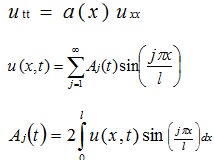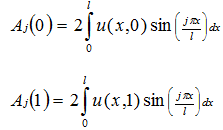Problem

Differentiating the above equation with respect to t twice and using Equation 1 leads to:

Integrating the first integral on the right-hand side by parts twice yields:
After applying the boundary conditions the above equation simplifies to:

The above equation is now a simple constant coefficient second-order differential equation. The boundary conditions are given by:

The second order differential equation can be solved analytically.

REQUIREMENTS
By applying the given boundary conditions, I need three cases solved analytically for the second order differential equation above.
1. First case
2( jΠ/l )2 ≈ 0
2. Second case
2( jΠ/l )2 > 0
3. Third case
2( jΠ/l )2 < 0
Each case will have a solution.
All the solution steps for the each case explaining how each step was made.